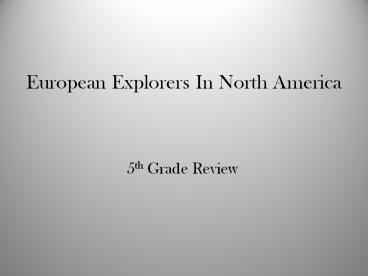European Explorers In North America - PowerPoint PPT Presentation
Title:
European Explorers In North America
Description:
Samuel de Champlain Samuel de Champlain was a French explorer who, in 1608, founded the Canadian city of Qu bec as a fur-trading post. – PowerPoint PPT presentation
Number of Views:427
Avg rating:3.0/5.0
Title: European Explorers In North America
1
European Explorers In North America
- 5th Grade Review
2
- Name the three European countries that were in
competition to extend their influence and
power to the newly discovered continent of North
America. _______________________________ - Each of these three countries were motivated by
the promise of ____________, a desire to
________________________, and a drive to expand
their __________ and _______________. These are
also known as competitive forces. - As the European explorers set out to claim the
vast lands of North America, they faced many
obstacles. Name the four major obstacles they
faced - 1). __________________________________
- 2). __________________________________
- 3). __________________________________
- 4). __________________________________
- Name the three major accomplishments of these
European explorers. - 1). ______________________________________________
___________________ - 2). ______________________________________________
___________________ - 3). ______________________________________________
___________________
Spain, France, and England
great riches
spread Christianity
empires
cultures
Poor maps and navigational tools
A lack of adequate supplies
Disease and starvation
Fear of the unknown
An exchange of ideas and goods between Europeans
and Indians
Improved navigational tools and ships
The major European powers claimed huge areas of
land
3
The Mariner's Astrolabe was used to determine the
latitude of a ship at sea by measuring the noon
altitude of the Sun or the meridian altitude of a
star of known declination. It was not possible
to determine longitude at sea in the early days
of transoceanic navigation, but it was quite easy
to determine latitude. To go to a place of known
latitude, the ship was sailed to that latitude
and then sailed east or west along the latitude
line until the place was reached.
4
Cabot explored eastern Canada for England!
John Cabot In 1497, Italian navigator John
Cabot sailed from England (sponsor country) to
North America. He was trying to find a Northwest
Passage to Asia. Cabot explored the coasts of
present-day Labrador and Newfoundland in eastern
Canada.
5
Coronado claimed land in the southwestern U.S.
for Spain!
Explorations of Coronado Spanish explorer
Francisco Vásquez de Coronado led one of the
earliest European expeditions to the Colorado
River region in 1540 and 1541. Coronado was in
search of gold or other riches that were rumored
to exist in the legendary Seven Cities of Cibola,
which were thought to be located in the
Southwest. Members of Coronados party did not
find the Seven Cities, but they probably did
become the first Europeans to view the Grand
Canyon.
6
Champlain established the French settlement of
Quebec!
Samuel de Champlain Samuel de Champlain was a
French explorer who, in 1608, founded the
Canadian city of Québec as a fur-trading post.
Champlain befriended the Algonquin and Hurons in
the area. With a party of indigenous peoples and
two French companions, Champlain led a raid on
the Iroquois, who were defeated largely because
the Europeans had firearms.
7
LaSalle claimed the Mississippi River Valley for
France!
Sieur de La Salle Claims Louisiana
Territory Sieur de La Salle settled in Canada in
1666. La Salle received a land grant near
Montréal and entered the fur trade. He also began
exploring the North American continent. During an
expedition on the Mississippi River in 1682, La
Salle claimed the entire Mississippi Valley for
France, naming the territory Louisiana.
8
Areas of Cooperation between the Europeans
Areas of Conflict between the Europeans
- Farm animals
- Transportation of firearms and farm tools
(technologies) - Trade
- Desire of English to spread Christianity
- Crops
- Land
- Competition for trade
- Disease
- Language differences
9
Cultural Interactions of Each European Ethnicity
Spanish
- Conquered and enslaved Indians
- Brought Christianity to the New World
- Introduced European diseases into the New World
10
Cultural Interactions of Each European Ethnicity
French
- Established trading posts in the New World
- Spread Christianity
11
Cultural Interactions of Each European Ethnicity
English
- Established settlements and claimed ownership of
land - Learned farming techniques from American Indians
- Traded
12
Timeline
England 1497-1498 Made two voyages under English flag. Explored Cape Breton Island and Nova Scotia also sailed along E and W coasts of Greenland, E coast of Labrador, W coast of Baffin Island, and a portion of S coast of Newfoundland.
John Cabot
Francisco Vásquez de Coronado
Spain 1540-1542 Traced Colorado R. northward, and sighted Grand Canyon explored S California, New Mexico, N Arizona, N Texas, Oklahoma, and E Kansas.
France 1603-1613 Traced course of Saint Lawrence R. northward to Lachine Rapids above Montréal, explored the E coast of North America S from Nova Scotia to Vineyard Haven, founded and named Québec, and explored Lake Champlain.
Samuel de Champlain
Sieur de La Salle
France 1682 Traced Mississippi R. to its mouth in Gulf of Mexico
13
(No Transcript)































